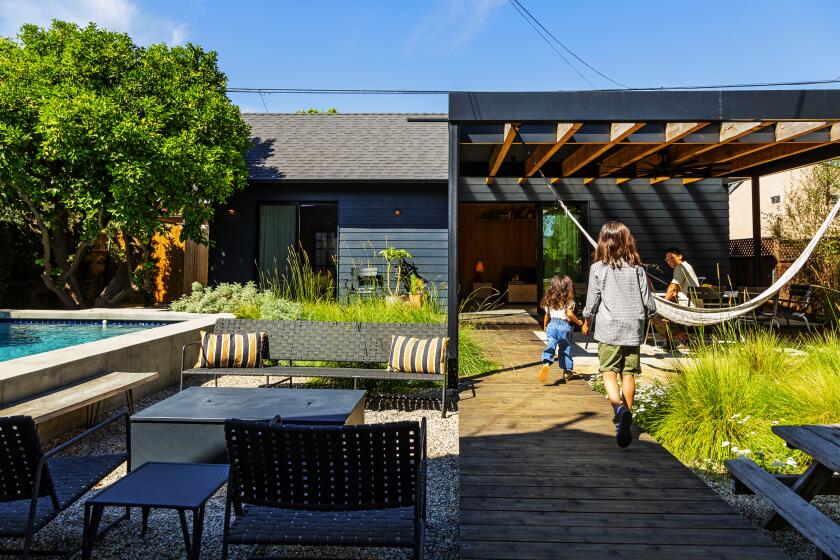HALCYON DAYS : Greene and Greene’s Gamble House, the Ultimate Bungalow
- Share via
It is a trip back in time, past the erratic collection of mirrored monoliths and taut towers that line the 134 Freeway from Burbank, through Glendale, to Pasadena, announcing for all who care to look that they are “now.” Then north on sedate and settled Orange Grove Boulevard and into a neighborhood known as the Upper Arroyo Seco, marked by large houses and lush landscaping hinting of a simpler era.
A turn onto Westmoreland Place, down a half-block or so, and there on a crest is the august Gamble House, a rambling, dark, wood-shingled structure with broad, overhanging eaves, a haunting mix of Alpine and Occidental styles. Through the welcoming, finely detailed stained-glass front door and into an interior of exquisitely joined, hand-sculpted wood, Tiffany lamps, crafted furnishings, all polished and aglow, and it is 76 years ago.
One of Southern California’s most precious period pieces, a local, state and national historic landmark, the Gamble House is a marvelous example of the concern and care that went into the design, construction and furnishing of homes for the gentry in the early 1900s. “I seek till I find what is truly useful; then I try to make it beautiful,” said Charles Sumner Greene, who with his brother, Henry Mather Greene, designed this sprawling, sublime residence.
Every detail in the planning of the Gamble House appears to have been carefully considered, from such major decisions as siting, scale and massing to more minor but no less critical decisions as whether to cover the brass screws fastening the interior wood trim with square pegs of ebony, mahogany or oak. The result is that the entire house--floors, walls, windows, moldings, ceilings, cabinets, lighting fixtures and brackets--is a work of art.
That is not exactly what David Gamble (of Procter & Gamble) had in mind when he asked the Greene Brothers to design the house in 1907. Gamble had retired to Pasadena, a favorite watering hole for the wealthy at the turn of the century, and in the spirit of the time and place wanted something comfortable that would take advantage of the region’s benign weather. He wanted an unostentatious, rustic house, although one executed with elegance, and with room, of course, for servants, house guests and large parties that could flow with ease between the house and the landscaped gardens--in short, something that would give form to an idealized vision of life in Southern California.
Ever since the Greene Brothers had arrived in Pasadena in 1893, fresh from the Midwest, they had been seeking that form, experimenting with materials and styles in executing increasingly challenging commissions for increasingly affluent clients. “The prime goal (of the Greene brothers) was to design pleasant places for living, loving and working, in a logical and humane way,” explains Randell Makinson, author of two definitive studies of the works of Greene and Greene and curator of the Gamble House. “But at the same time they were asking such questions as ‘What is California?’ and ‘What is it like to live here?’ ”
The result of their search is the Gamble House. It has been described as a cross between a Swiss chalet and a Japanese minka , and also as, simply, “the ultimate bungalow.” If a bungalow, it is certainly a very privileged rendition of the modest, wood-shingled, porch-encrusted structures that sprouted out of the builders’ catalogues of the early 1900s and sprawled across the burgeoning Los Angeles landscape (thanks in part to the cheap lumber that was just beginning to flow into Southern California by ship from the Northwest). The Gamble House also cost about 50 times more to build than the average bungalow, coming in at a price of $50,400. Another $3,500 was spent on the garage, and $7,000 for the furnishings and fixtures.
If anything, it is an example--some consider it the finest example--of the Arts and Crafts Movement that flourished in the halcyon period around the turn of the century. The movement was dedicated to the proposition that good design involved good craftsmanship, and that it should envelop man as a total experience and not simply be applied as ornamentation. Of all the architectural styles that have swept through Southern California over the last 100 years, from florid Victorian and sentimental Spanish Colonial to mannered Modern and high- gloss High Tech, the Arts and Crafts Movement appears to have been most at home here, however fleeting.
It is that brief period that is captured in the Gamble House, especially when lit with a golden haze filtering through the stained glass during the day and from the Tiffany lamps at night. The ambiance prompts reverential whispers from those who visit the house, which is open for guided tours Tuesdays and Thursdays between 10 a.m. and 3 p.m. and Sundays from noon to 3 p.m., except on major holidays. Those interested are asked to telephone (818) 793 3334 or (213) 681 6427.
The tours are conducted by the docents council of the Friends of the Gamble House, which is 300 members strong. It was formed as a support group after the Gamble family made a gift of the house to the City of Pasadena in 1966 in a joint agreement with USC. The school, with the help of the Friends, now operates the house as a national monument
In discussing the Greene Brothers’ concern for details (“the noblest work of art is to make common things beautiful for man,” Charles Greene once commented) and the docents’ concern for preservation (“Please take your shoes off and put on these soft slippers,” the tour guides request), Makinson says that “love created the house, and love maintains it.”






